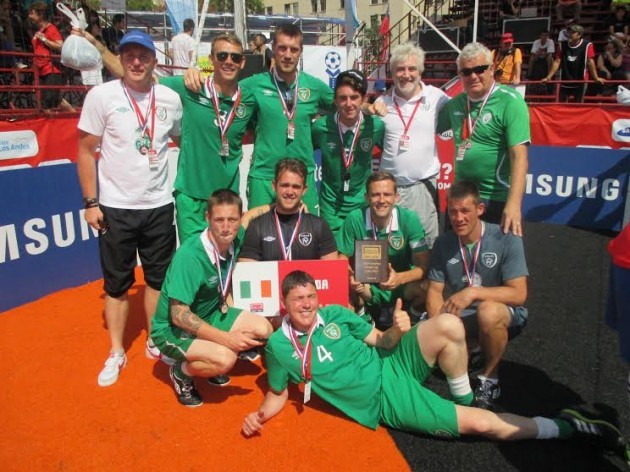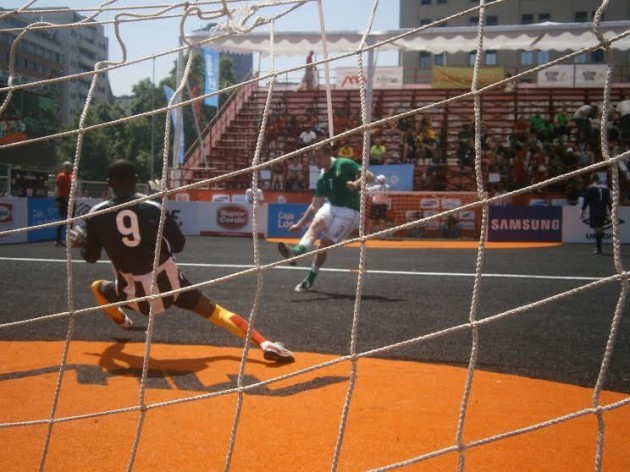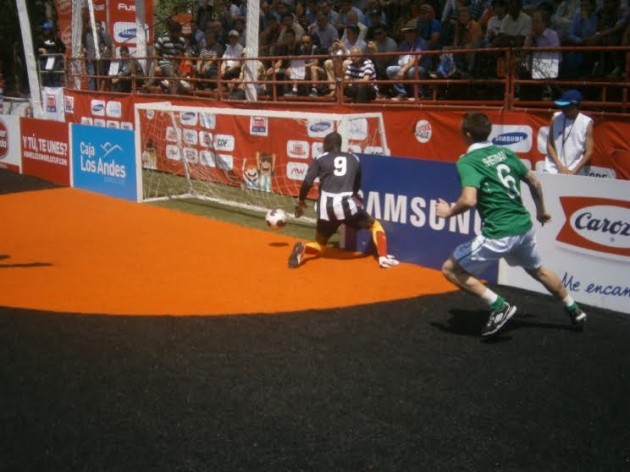EVERY YEAR, thousands of Irish people and millions worldwide regularly spend nights on the street sleeping rough.
In November, homeless charity Focus Ireland estimated that 100 children became homeless over the course of just a month.
Moreover, the problem seems to be reaching crisis point, and was starkly highlighted by the recent death of a homeless man in a doorway on Molesworth Street, just metres from Leinster House.
But while the situation may be dire, it is far from hopeless. Two people who managed to emerge from such traumatic experiences are Thomas O’Dwyer and James Traynor. And not only have they been able to find solace in a healthier and safer lifestyle, they also represented Ireland on the world stage in the process.
Yet at one point, for Traynor, competing at the 2014 Homeless World Cup and receiving messages of support from famous rugby and soccer stars would have seemed little more than a pipe dream.
Not so long ago, as far as the Dubliner was concerned, playing soccer was virtually unthinkable and simply getting outside his own head felt like an ordeal.
“I’d been on the streets since I was 13,” he tells TheScore.ie. “It was a long time. Over a decade. I had that lack of self esteem — everything was always negative. Life gets away from you and life goes on no matter what.
“Coming from that lifestyle, I tended to believe everything was negative. You think: oh shit, why is this happening? Then another thing happens.
“But now, it’s not really like that at all, even if life still happens.”
And while getting involved in football and joining the Irish Street League was a big part of his rehabilitation, Traynor is keen to stress that it was just one factor of many.
“I had to do it myself,” he says. “I think the football helped me to believe in myself and helped me more socially.
“The homelessness thing was fixed beforehand. It was just about getting out and believing in myself more than anything else. It was about meeting the world halfway — the rest takes care of itself.
“I’m more social now around friends and open to meeting people. Before, I’d be in my head and I wouldn’t be able to say much really. Now, I don’t care what I say. I am who I am.”
Like many of his Irish teammates, Traynor is an ex-addict who is currently involved in a 12-step programme as part of his rehabilitation. He describes how simply showing up for regular activities such as football is an important part of combating the continuing temptations of drugs and alcohol.
“Football alone won’t help you,” he explains. “It’ll help you socially, but you have to keep doing it. You make friends — people want to get your number and say: ‘we have a game next week, do you want to be involved?’ And then, you’ll probably get on a football team.”
Having initially been reluctant to return to play football for the first time in years, the wheel has come full circle and Traynor now helps organise the group’s bi-weekly gatherings.
“I say ‘just go down, show your face, you don’t even have to kick a ball’. We’re not looking for Maradonas. We’re looking for people with the right character and the right frame of mind.
“I’m more or less encouraging people who I meet — old players, new players — to get their ass down there… So hopefully people turn up. It’s up to them to get off their arse.”
Indeed, simply ‘turning up’ has gotten Traynor much further than he ever would have imagined. Last October, the goalkeeper was one of eight Irish players to travel to Chile for this year’s Homeless World Cup, having previously been a keen participant in the Irish Street League.
Traynor admits he previously dared not dream of hitting such heights and is modest about his achievement of being chosen from an initial group of roughly 500 candidates to represent his country.
“I didn’t believe I was going to get picked when I started,” he says. “I’m hitting 40 and I thought ‘they’re not going to pick me out of 500 people,’ as there was a lot of other good keepers there.
“But you don’t have to be a world-class footballer to get picked. And if a world-class footballer has an attitude, he won’t get picked, because of his anger or whatever. So if you can kick a ball, just come down — you never know what might happen.”
The 39-year-old adds that the long, arduous selection process was a surreal and at times baffling experience.
“We all had a game and I thought: ‘Is this a competition?’ It was explained that you could get a call back and it was for the Homeless Street League. I still wasn’t convinced by it, but over the weeks, the group became smaller.
“Eventually, there were 13 players left and I got picked. It still didn’t sink in that [playing in the World Cup] was what I was going to be doing. I was going to training and I still wasn’t really understanding what it was all about, even when the manager was coming up to us with Irish team gear.
“When we went to the Mansion House dressed in Irish clothes and there were cameras, we were thinking: ‘What’s going on here?’ They took a few pictures but everyone was freaked on the stage not knowing what was going on. It was only when I got over there that it really sunk in [what was happening].”
The ensuing experience, Traynor recalls, was “incredible”.
“The audience, the different teams and cultures, representing your country and standing there for the national anthem for the first time… It blew me away.
“Just being out with the lads as well — I was singing ‘The Fields of Athenry’ through the streets. You could see other teams wondering: ‘Who’s that? Some crazy Irish fella.’ I started singing it at the top of my voice in a really Irish kind of way.”
A group of South American-based Irish supporters even showed up to support Traynor and co, with the team ultimately finishing a respectable 16th out of 42 teams.
Mick Pender’s side picked up some impressive wins over the likes of Wales, Greece and Romania during the tournament, but the Chilean heat and humidity meant countries such as Brazil were always going to have an advantage over Ireland and other nations unused to such extreme conditions.
“Even five minutes on that pitch in 40 degrees was tough,” Traynor explains. “You’d find it hard to breathe. Some of us were sick when we got over there, because our throats were closing up. So it took its toll on us.
“Our runners were getting stuck to the pitch. Some of the lads were also complaining about bits of the pitch coming up and stuff like that, but I still enjoyed it because of the atmosphere.”
While the experience may ultimately have ended in disappointment, Traynor says it is one he won’t forget too soon, as he lapped up his brief flirtation with fame.
“I thought I was a superstar,” he laughs. “When I came over, I was even asking people: ‘Do you want my autograph?’ So I was having fun with it.”
Meanwhile, his teammate and Ireland’s captain Thomas O’Dwyer concurs that it was a “great experience,” and — in addition to getting to see the Andes — he cites the Irish team’s thrilling encounter with Costa Rica as the highlight of the trip.
“We won 6-5, but we were 5-2 down at one stage, and we got a blue card, which meant the player was off the field for a few minutes, so we had just two outfield players and the two boys got it back to 5-5.
“I came on then and we got the winner, so that was a standout moment. It showed we could compete in the heat even with a man down.”
O’Dwyer emphasises that matches in the competition, which involved one goalkeeper and three outfield players — one of whom had to be in the opposition’s half at all times — are completely incomparable to regular 11-a-side soccer.
“Most teams had two defenders, so it was all about defending,” he says. “There’s a big difference — whatever you know at 11-a-side level, you can put it out of your head, because it’s totally different. There’s a lot of stamina [involved] in four-a-side. It’s also a lot quicker.”
Like Traynor, O’Dwyer came from a troubled background and suffered from addiction at one point.
“I’m okay now, but before I was just drinking too much,” he says. “It’s important to just stay strong and talk — it always helps to talk to someone.”
Traynor echoes his colleague’s sentiments.
“If I can [overcome addiction], coming from the lifestyle I came from, anyone can do it. It’s as simple as that. It’s about having a belief in yourself.
“I encourage anyone who has that lifestyle or had that lifestyle to get involved. Wherever they are in Ireland, I’d put my hand out to help anyone and other people will too.”
More info on the Irish Street League can be found here.
All pics provided courtesy of Sean Kavanagh.



